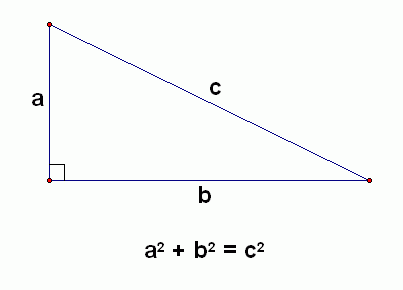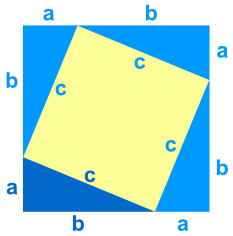What is the Pythagorean Theorem?
The Pythagorean Theorem states that, in a right triangle, the square of a (a²) plus the square of b (b²) is equal to the square of c (c²):
a2 + b2 = c2
Proof of the Pythagorean Theorem using Algebra
We can show that a2 + b2 = c2 using Algebra
Take a look at this diagram ... it has that "abc" triangle in it (four of them actually):
Area of Whole Square
It is a big square, with each side having a length of a+b, so the total area is:
A = (a+b)(a+b)
Area of The Pieces
Now let's add up the areas of all the smaller pieces:First, the smaller (tilted) square has an area of A = c²
And there are four triangles, each one has an area of A =½ab
So all four of them combined is A = 4(½ab) = 2ab
So, adding up the tilted square and the 4 triangles gives: A = c²+2ab
Both Areas Must Be Equal
The area of the large square is equal to the area of the tilted square and the 4 triangles. This can be written as:
(a+b)(a+b) = c²+2ab
NOW, let us rearrange this to see if we can get the pythagoras theorem:Start with: (a+b)(a+b) = c² + 2ab
Expand (a+b)(a+b): a² + 2ab + b² = c² + 2ab
Subtract "2ab" from both sides: a² + b² = c²
DONE!
Now we can see why the Pythagorean Theorem works ... and it is actually a proof of the Pythagorean Theorem.
This proof came from China over 2000 years ago!
There are many more proofs of the Pythagorean theorem, but this one works nicely.



No comments:
Post a Comment